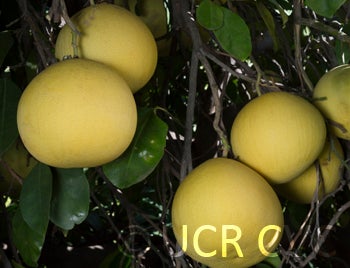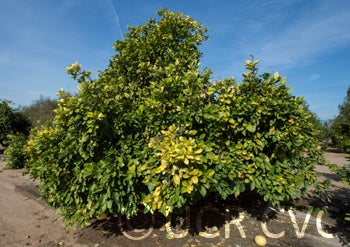Citrus maxima (Burm.) Merr.
CRC 3927
PI 539394
VI 447
Source
Received as budwood from Hawaii, 1984.
Parentage/origins
Parents unknown.
Rootstocks of accession
Carrizo citrange
Season of ripeness at Riverside
Unknown.
Notes and observations
EMN, 1986: Original import had exocortis, tristeza, and concave gum; these were removed by shoot tip grafting.
EMN, 11/13/1989: Has pink tinge in flesh & albedo as in CI description; so appears true-to-type.
EMN, 12/14/1989: C.I. description fits well. Still slightly tart- not as good in flavor as Kao Phuang next door at this time. Even so, pink tinge might make this one a winner.
OJB:Thong Dee pummelo is of the Thai group of pummelos. The trees are large and vigorous. The fruit is very large and broadly obovoid to oblate, with a slightly depressed apex. The smooth light yellow rind is medium-thin and tightly adherent. The flesh is tinged pink and the flavor is good when grown under appropriate climatic conditions. The pulp is juicy and easily separable from the membrane walls. When cross-pollinated, the fruit is very seedy. Early introductions of this variety into California were by seed and the fruit lacked the pink flesh pigmentation, but the latter introduction, via budwood and currently available, fits the standard well. Thong Dee is midseason in maturity and holds well on the tree.
Description from The Citrus Industry Vol. 1 (1967)
"Fruit medium-large, very broadly obovoid to oblate; apex slightly depressed; seedy. Light yellow at maturity. Rind medium-thin, smooth, and tightly adherent. Under favorable conditions both albedo and flesh are pink-tinged, the latter in streaks. Carpellary membranes thin but tough and readily separable from pulp. Vesicles large; juice plentiful; flavor good. Midseason in maturity.
Tree vigorous and large.
The description of this Siamese variety was adapted from Groff (1927) and does not correspond with the clone received in California in 1930 from the U.S. Department of Agriculture. Groff states, however, that the original materials sent to the United States consisted of seeds and seedlings. The clone in the California collections produces non-pigmented fruits of indifferent quality. That grown in Florida seems to be different since it is reported to correspond with Groff's description."
Availability
Commercially available in California through the Citrus Clonal Protection Program. Click here to order budwood.
USDA Germplasm Resources Information Network page for Thong Dee pummelo


